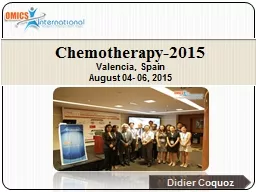

Valencia Spain August 04 06 2015 Evolution of cancer drug development and registration paradigms in light of the successes of immunotherapy Dr Didier Coquoz Copexis Switzerland dccopexiscom ID: 807433
Download The PPT/PDF document "Didier Coquoz Chemotherapy-2015" is the property of its rightful owner. Permission is granted to download and print the materials on this web site for personal, non-commercial use only, and to display it on your personal computer provided you do not modify the materials and that you retain all copyright notices contained in the materials. By downloading content from our website, you accept the terms of this agreement.
Slide1
Didier Coquoz
Chemotherapy-2015Valencia, SpainAugust 04- 06, 2015
Slide2Evolution of cancer drug development and registration paradigms in light of the successes of immunotherapyDr. Didier Coquoz, Copexis, Switzerland dc@copexis.com
International Conference on
Antimicrobial Agents and ChemotherapyAugust 04-06, 2015 Valencia, Spain
Slide3Some trial considerations Usual situation for many FDA drug approvalsMultiple studiesStudies are large 1,000 – 5,000 patientsPlacebo control groupDouble blinded or a blinded independent assessmentHighly significant p values (0.001) Oncology drug data submitted for approvalOne study, 100 –
800 patients No blinding, no placebo control Heterogeneous patient group Statistical evidence ~ 0.03 – 0.05
Slide4Failure rates
Slide5LIVE LONGER – Measure Survival- PFS/DFS/OSEfficacy, reassures for safety, unbiased endpoint but – subsequent therapy, long time requiredPFS/DFS often viewed as surrogate for OS: Colorectal cancer: 3 year DFS (p ≤ 0.03) => 5 year OS LIVE BETTER – Measure QOL – PROImportant: control group + blinding needed (bias) hard to measure, scale problems, missing data Drug Tox. symptoms versus tumor
symptomsSAFETY (Benefit / Risk assessment)=> COMPARISONS ARE NECESSARY HOW? controlled clinical trials
Slide6Early 90’sImmunomodulators: Interleukin 2Considered as a “failure” mainly due to SAEEarly 90’s - currentImmunomodulators: noneMonoclonal antibodies, bi-specific antibodies (however not immunomodulators)Therapeutic vaccines: essentially one: Sipuleucel-T
From 2013Anti-CTLA4 (Yervoy®), anti-PD1 (Opdivo®), anti-PDL1…Check point inhibitors cytokines, immunocytokinesSuccesses of immunotherapy
Slide7Immunomodulators, vaccines:Goal: increase the immune responseCancer develops immunosuppressive strategiesvaccines: reduction of efficacyImmunodulators
Anti-CTLA4, -PD1, -PDL1, check point inhibitors: inhibit the immuno downregulation mechanisms. Risk: over-immuninityCytokines, immunocytokines: inhibit the immuno
downregulation mechanisms. Risk: over-immuninity, or bypass the cancer induced immunosuppressive mechanismsCancer develops immunosuppressive strategiesvaccines: reduction of efficacyImmunodulatorsAnti-CTLA4, -PD1, -PDL1, check point inhibitors: inhibit the immuno downregulation mechanisms. Risk: over-immuninityCytokines, immunocytokines: inhibit the immuno downregulation mechanisms. Risk: over-immuninity, or bypass the cancer induced immunosuppressive mechanismsChallenges of immunotherapy
Slide8Immunomodulators, vaccines: Different MoA and response pattern relative to cytotoxics, TKIs etc..:MoA: stimulation of the immune cellsMoA consequences:Invasion of the tumor
by immune cells and immune reactionProbably less efficacious on bulk tumorProbably more efficacious on cancer initiating cells, residual
disease and metastasesClinical potential:Probably most efficacious in combination with other anti-cancer treatments (costs!)Potential of cure ! (total eradication of the cancer including residual disease and metastatses)Challenges of immunotherapy
Slide9results from T-cell immune response assays as biomarkers for clinical surrogacy are highly variable and often non reproducible harmonisation of assaysimmunotherapy induces novel patterns of the antitumour responses not captured by WHIO criteria or Response Evaluation Criteria in Solid Tumours (RECIST)
new immune-related response criteriaimmunotherapy induced survival curves can show a delayed separationmodified statistical models are needed to describe the hazard ratios as a function of time, and differentiate them before and after separation of curves to improve planning of phase III trials
Challenges of immunotherapyHoos. A. Ann
Oncol 2012; 23
Slide10inter-laboratory
variability
in immune response measurements Hoos. A. Ann Oncol 2012; 23
Slide11Novel response patterns observed with
immunotherapies
Hoos. A. Ann Oncol 2012; 23
Slide12model
scenario demonstrating
implicationsof delayed separation of survival curves.Hoos. A. Ann Oncol 2012; 23
Slide13Immune-related response criteria identify survivors among 227 patients enrolled in phase II studies of
ipilimumab
10 mg/kg monotherapy that would have had progressive disease according to modified World Health Organisation criteria Wolchock, JD et al., Clin Cancer Res 2009; 15(23)
Slide14immune-related
response criteria
patients from 3 melanoma cohorts treated with pembrolizumab (n=411)Hodi et al. J. Clin. Oncol
. 2014, 32:5s (suppl: abstr. 3006) © The Author 2012. Published by Oxford University Press on behalf of the European Society for Medical Oncology. All rights reserved. For permissions, please email: journals.permissions@oup.com.
Slide15immune-related
response criteria
patients from 3 melanoma cohorts treated with pembrolizumab (n=411)Hodi et al. Jo. Immuno Ther
. Cancer 2014, 2(Suppl3): P103 © The Author 2012. Published by Oxford University Press on behalf of the European Society for Medical Oncology. All rights reserved. For permissions, please email: journals.permissions@oup.com.
Slide16challenges and recommendations for immunotherapy
Hoos
. A. Ann Oncol 2012; 23Cellular immune response
Antitumour responseSurvivalChallengesComplex assays existConventional and novel response patterns are observedTranslation of immune and antitumour response into a survival effect takes timeResults are highly variable and not reproducible across trialsTranslation of the immune response into an antitumour response takes timeProportional hazards assumptions are not applicableAssay procedures are not harmonisedNo systematic criteria exist to capture new response patternsConventional statistical models do not account for nonproportional hazards and delayed separation of curvesRecommendationsHarmonise assay use through standard operating procedures that accompany individual assay protocolsIdentify relevant response patternsEmploy statistical models that account for the delayed effectUse systematic immune-related response criteria to reproducibly capture new patternsConsider use of early interim and futility analyses
Slide17challenges and recommendations for immunotherapy
Wolchock
, JD et al., Clin Cancer Res 2009; 15(23)
Slide18Main referencesHoos A., Ann Oncol 2012; 23: viii47-viii52Naidoo J. et al., Br. J. of Cancer 2014; 111: 2214–2219Wolchok et al., Clin Cancer Res 2009; 15(23): 7412-7420Hodi et al. J. Immuno Ther. Cancer 2014, 2(Suppl3): P103
Hodi et al. J. Clin. Oncol. 2014, 32:5s (suppl: abstr. 3006)
Slide19Chemotherapy-2016
Website: chemotherapy.conferenceseries.comMeet the eminent gathering once again atChemotherapy-2016
Dallas, USAJune 06-07, 2016